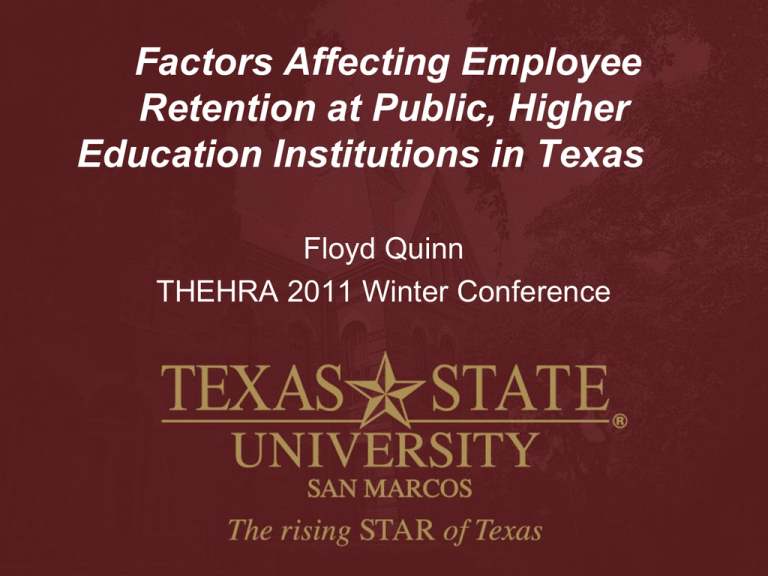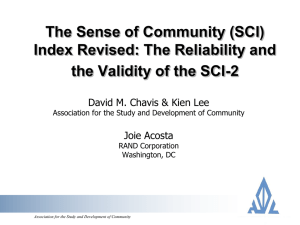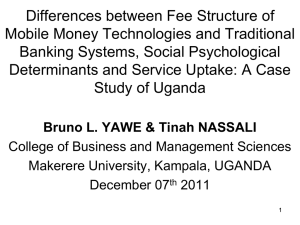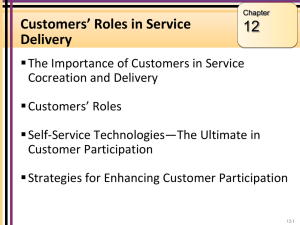4Factors
advertisement

Factors Affecting Employee Retention at Public, Higher Education Institutions in Texas Floyd Quinn THEHRA 2011 Winter Conference Factors Affecting Employee Retention at Public, Higher Education Institutions in Texas Background Theoretical Framework Literature Review Study Framework – Instrument – Sampling – Methods of Analysis – Definitions Research Findings Lessons Learned Factors Affecting Employee Retention at Public, Higher Education Institutions in Texas Legislative Study – An Annual Report on FullTime Classified State Employee Turnover for Fiscal Year 2004 Instrument – Survey of Organizational Excellence (SOE) Collaborative effort with Dr. Noel Landuyt, Research Associate, The Institute for Organizational Excellence, located at The University of Texas at Austin The statements with the greatest difference in scores between those employees planning to stay and those intent to leave Scaled: 5 Strongly Agree to 1 Strongly Disagree Intend to Stay Intend to Leave We are given the opportunity to do our best work. 3.65 2.88 Every employee is valued. 3.42 2.48 Outstanding work is recognized. 3.25 2.46 We feel our efforts count. 3.34 2.55 We are efficient. 3.58 2.86 There is a real feeling of teamwork. 3.31 2.59 The amount of work I am asked to do is reasonable. 3.47 2.86 We feel the channels we must go through at work are reasonable. 3.41 2.71 Overall finding - “Employees indicating that they intend to leave feel as though they are not given the opportunity to do their best work and are not highly valued. They express dissatisfaction with how work is recognized and the sense of teamwork within the workplace. Moreover, they do not feel as though the workplace is efficient and has too many unreasonable barriers to successfully completing tasks.” Research Question How does employee development affect intention to stay at 4-year, public institutions of higher education in Texas? Additionally, the study will examine the influence of several other factors (supervisor effectiveness, team effectiveness, and job satisfaction) on employee intention to stay. Theoretical Framework Frederick Herzberg Herzberg, F. (1959). Motivation to work. New York, NY: John Wiley & Sons, Inc. Job-Attitude Factors – First-Level Factors – Second-Level Factors Satisfiers (motivating factors) versus Dissatisfiers (hygiene factors) Theoretical Framework First-Level Factors – Results from researcher coding of objective events Second-Level Factors – Results from researcher coding of respondent interpretation of objective events Theoretical Framework Percentage of Each First-Level Factor Appearing in High Attitude Sequences N=228 Factor Total (%) 1. Achievement 41 2. Recognition 33 5. Advancement 20 7. Possibility of growth 6 8. Interpersonal relations – subordinate 6 10. Interpersonal relations - peers 3 11. Supervision – technical 3 Theoretical Framework Percentage of Each Second-Level Factor Appearing in High Job-Attitude Sequences n=228 Factor 1. Recognition 2. Achievement 3. Possible growth 4. Advancement 5. Responsibility 6. Group feeling Total (%) 59 57 38 3 30 10 Theoretical Framework Percentage of Each First-Level Factor Appearing in Low Job-Attitude Sequences N=228 Factor Total (%) 1. Company policy and administration 31 2. Technical supervision 20 3. Recognition 18 4. Salary 17 5. Interpersonal relations – superior 15 6. Work itself 14 7. Working conditions 11 Theoretical Framework Percentage of Each Second-Level Factor Appearing in High and Low Job-Attitude Sequences N=228 Factor Total (%) 1. Fairness-unfairness 38 (Integrity/block to growth) 2. Possible growth 33 3. Achievement 19 4. Pride, guilt, inadequacy 14 5. Salary 13 6. Work itself 13 Theoretical Framework J. Stacey Adams Miner, J. (2005). Organizational behavior 1: Essential theories of motivation and leadership. Armonk, NY: M.E. Sharpe. Equity Theory People may feel that they are under-rewarded in terms of what they put into a job in comparison to what other workers are getting for their contributions. Literature Review Rowden, R. (2002). High performance and human resource characteristics of successful small manufacturing and processing companies. Leadership & Organization Development Journal, 23(1), 79-83. doi:10.1108/01437730210419206 Rowden sought to identify the high performance work practices of selected successful companies operating in the southeastern portion of the United States. Results indicated that the most commonly shared high performance work practices of the companies participating in this research included training and development opportunities. Rowden concluded that the most important corporate success strategy is a commitment to the training and development of employees working for the organization. Literature Review Owens, P. (2006). One more reason not to cut your training budget: The relationship between training and organizational outcomes. Public Personnel Management, 35(2), 163-171. Owens investigated the relationship between training participation and turnover intention. In researching his topic, Owens generated a sample consisting of employees from a local state government subdivision in the southeastern United States. These employees either had or had not completed a supervisory training course consisting of basic supervisory skills, communication skills, and a review of organizational policies and procedures. The results of the study indicate a strong positive correlation between training participation and turnover intention. Literature Review Sahinidis, A. & Bouris, J. (2008). Employee perceived training effectiveness relationship to employee attitudes. Journal of European Industrial Training, 32(1), 63-76. doi:10.1108/03090590810846575. Sahinidis & Bouris investigated the relationship between perceived employee training effectiveness and job satisfaction, motivation, and commitment. The authors surveyed 134 employees of five large Greek organizations after they had completed a performanceenhancing training program. The questions asked of these participants were related to attitudes toward the training program and their employers. The results of the study indicate that there exists a positive relationship between perceived training effectiveness and job satisfaction, motivation and commitment to an employer. Literature Review Chew, J. & Chan, C. (2008). Human resources practices, organizational commitment and intention to stay. International Journal of Manpower, (29)6, 503-521. doi: 10.1108/01437720810904194 Chew & Chan examined the impact of key human resource practices on employee organizational commitment and intention to stay. One of these practices was the implementation of training and career development strategies. The study participants were full-time employees of nine large public and private organizations operating in Australia. Researchers concluded that training and development has significant positive association with an employee’s intention to stay with an employer. Literature Review Soonhee, K. (2005). Factors affecting state government information technology employee turnover intentions. American Review of Public Administration, June, 137156. doi:10.1177/0275074004273150. Surveys were disseminated to IT employees working in the central IT departments of two state governments to examine how job characteristics, work environment and human resource management practices shape their turnover intentions. The results of the study indicated that effective communications with management, a participative management approach, organizational support of career development, and opportunities for advancement are all significant variables affecting job satisfaction. Literature Review Ellickson, M. & Logsdon, K. (2001). Determinants of job satisfaction of municipal government employees. State and Local Government Review, 33(3), 173-184. doi:10.1177/0160323X0103300302. In a study that investigated determinants of job satisfaction of municipal government employees, Ellickson and Logsdon collected surveys from 1,227 fulltime, municipal employees representing 18 departments and serving approximately 200,000 citizens in the Midwestern region of the United States. The questionnaire was designed to explore and ascertain employee views about certain aspects of the workplace including training, workload, departmental esprit, pay, benefits, promotional opportunities and supervision. An analysis of the data revealed that each of these variables positively and significantly correlated with the study’s dependent variable: employee job satisfaction. Literature Review Wright, B. & Davis, B. (2003). Job satisfaction in the public sector: The role of the work environment. The American Review of Public Administration, 33(1), 70-90. doi:10.1177/0275074002250254. Wright and Davis examined the influence of the work environment on public employee feelings of job satisfaction. Surveys were distributed to 385 New York State employees selected through the use of a randomized process and representing 11 public service agencies. The findings of the study found a positive and significant relationship existed between job satisfaction and HRD opportunities in the workplace and served to add credence to their belief that “public organizations can leverage the positive effects of greater job satisfaction by developing clear strategies that embrace the HRD needs of their employees.” Study Framework Non-experimental Instrument – SOE – FY2008 Data Convenience Sample – Eight Texas Institutions of Higher Education Small to Midsize Institutions Rural to Urban Locations Staff Analysis – Faculty Removed From Dataset – Incomplete Records Removed from Dataset 1,083 Total Records Powerful Sample Study Framework Methods of Analysis – Bivariate correlations in SPSS – Structural Equation Modeling (SEM) using linear and logistic regression in AMOS Definitions – Employee development – perceived organizational commitment to training – Team effectiveness – perceived efficiency and effectiveness of a work group – Supervisor effectiveness – perceived supervisor performance (competence) – Job satisfaction – perceived quality of the work environment in terms of performance and work-life balance – Intention to stay – response to the single survey item, “I plan to be working for this institution in two years.” Group Activity From your own experiences, discuss your anticipated outcomes of the following analyses: The effects of supervisor effectiveness, team effectiveness and employee development on job satisfaction. The effects of supervisor effectiveness, team effectiveness and employee development on intention to stay. Research Findings Correlations JobSat - EmplDev JobSat Sig. (2-tailed) N EmplDev Sig. (2-tailed) N .643** .000 1083 .643** .000 1083 ** Correlation is significant at the 0.01 level (2-tailed). Research Findings Correlations JobSat-TeamEff JobSat Sig. (2-tailed) N TeamEff Sig. (2-tailed) N .737** .000 1083 .737** .000 1083 ** Correlation is significant at the 0.01 level (2-tailed). Research Findings Correlations SuperEffect-JobSat SuperEffect Sig. (2-tailed) N JobSat Sig. (2-tailed) N .771** .000 1083 .771** .000 1083 ** Correlation is significant at the 0.01 level (2tailed). Research Findings Correlations EmplDev-WorkTwoYears EmplDev -.204** Sig. (2-tailed) .000 N 1083 WorkTwoYears -.204** Sig. (2-tailed) .000 N 1083 ** Correlation is significant at the 0.01 level (2-tailed). Research Findings Correlations TeamEff-WorkTwoYears WorkTwoYears -.212** Sig. (2-tailed) .000 N 1083 TeamEff -.212** Sig. (2-tailed) .000 N 1083 ** Correlation is significant at the 0.01 level (2-tailed). Research Findings Correlations SuperEffect-WorkTwoYears WorkTwoYears -.223** Sig. (2-tailed) .000 N 1083 SuperEffect -.223** Sig. (2-tailed) .000 N 1083 ** Correlation is significant at the 0.01 level (2-tailed). Research Findings Correlations JobSat-WorkTwoYears WorkTwoYears -.192** Sig. (2-tailed) .000 N 1083 JobSat -.192** Sig. (2-tailed) .000 N 1083 ** Correlation is significant at the 0.01 level (2-tailed). Lessons Learned Supervisor effectiveness strongly correlated to employee job satisfaction. It was the singlemost contributing factor in this study. Team effectiveness strongly correlated to employee job satisfaction and had a significant practical effect. Employee development strongly correlated to employee job satisfaction but had an insignificant practical effect. In SPSS, team effectiveness, supervisor effectiveness and employee development did not correlate to a significant practical degree to employee intention to stay. Lessons Learned In AMOS, team effectiveness, supervisor effectiveness and employee development were shown to have little practical effect on employee intention to stay. As such, these variables are not considered contributing factors in such decisions. Job satisfaction did not correlate to a significant practical degree with employee intention to stay. In reviewing the dataset, 9% of respondents anticipated leaving their employer within two years while 29% indicated they were dissatisfied with their employment.






